How Celebrities’ Green Messages on Twitter Influence Public Attitudes and Behavioral Intentions to Mitigate Climate Change
Abstract
1. Introduction
2. Role of Emotion in Environmental Advocacy
3. Role of Celebrity Involvement in Environmental Advocacy
4. Parasocial Relationship with Celebrity Advocates
5. Method
5.1. Participants
5.2. Pilot Tests
5.3. Materials
5.4. Procedure
5.5. Measures
6. Results
6.1. Manipulation Checks
6.2. Effects of Climate Advocacy Messages on Pro-Environmental Attitudes and Behaviors
6.3. Effects of Emotional Framing and Framing of Celebrity Involvement on Pro-environmental Attitudes and Behaviors
6.4. Process of Role Modeling in Adoption of Pro-Environmental Behaviors
7. Discussion
8. Limitation and Future Studies
9. Conclusions
Funding
Acknowledgments
Conflicts of Interest
Appendix A
| Measures | Items |
|---|---|
| Risk awareness | 1. The consequences of climate change will be severe. 2. Impacts of climate change are likely to be extreme. 3. The effects of climate change are unlikely to be too serious. (Reverse Coded) |
| Perceived response efficacy | 1. I believe my actions can have a beneficial influence on global warming and climate change. 2. My actions to reduce the effects of global warming and climate change in my community will encourage others to reduce the effects of global warming through their own actions. 3. Actions I take personally can help reduce the effects of climate change. 4. Climate change can be averted by mobilising collective effort. 5. If we act collectively, we will be able to minimise the consequences of climate change. |
| Attitude | 1. Overall how do you feel about climate change mitigation? 2. In terms of personal considerations only, do you feel overall positive or negative about climate change mitigation? 3. Thinking about climate change mitigation in social terms, i.e., with regard to being a member of society, do you think that climate change mitigation is overall a positive or a negative thing? |
| Support for government action on climate mitigation | 1. We should immediately increase government regulation on industries and businesses that produce a great deal of greenhouse emissions. 2. We should immediately increase taxes on industries and businesses that produce a great deal of greenhouse emissions. 3. Concern about global climate change is unwarranted and no action is needed (reverse coded). 4. The government should offer economic incentives so that businesses and industries voluntarily reduce greenhouse emissions. 5. The government should enact economic policies that will encourage to reduce greenhouse gas emissions. 6. In terms of personal considerations only, do you feel overall positive or negative about climate change mitigation? |
| Sustainable Behavior | 1. Switch off lights when not in use 2. Set thermostat at 68°F or lower in winter. 3. Buy local foods when possible. 4. Eat vegetarian meals. 5. Wash and dry only full loads. 6. Recycle more. 7. Compost. |
| Participation in activism | 1. Participate in events organized by environmental groups working for climate change mitigation. 2. Give financial support to environmental groups working for climate control. 3. Circulate petitions demanding an improvement of government policies regarding climate change mitigation. 4. Participate in protests for mitigating climate change. 5. Punish companies that deny the causes of climate change by not buying their products. 6. Write posts on social media to urge people to take an action for climate change. 7. Join or follow groups or pages on social media that are related to the activism or movement for climate change mitigation. 8. Share information or links on social media that are related to climate change. |
| PSR | 1. I feel he is like a friend 2. I see him as a natural, down-to-earth person. 3. I look forward to seeing him on any media. 4. If he appeared on any media, I would want to watch it. 5. He seems to understand the kinds of things I want to know. 6. If I saw a story about him in a newspaper or magazine, I would want to read it. 7. I would miss him if I could not see him on any media for a while. 8. If I could, I would like to meet him in person. 9. I would feel sorry for him if he made a mistake. 10. I find him to be attractive. |
| Belief in climate change | 1. Belief in the existence of climate change: You may have heard about the idea that the world’s temperature may have been going up over the past 100 years, a phenomenon sometimes called ‘climate change’ or ‘global warming’. Please indicate to what extent you agree or disagree that this has been happening. 2. Belief in human contributions to climate change: Please indicate to what extent you agree or disagree with the statement: “global climate change is occurring and we humans are the primary cause” |
| Knowledge of climate change | 1. The hole in the ozone layer is the main cause of global climate change. (F) 2. The average temperature of the earth has increased over the past 100 years. (T) 3. The greenhouse effect is due to Streams of heat that do not get out of the atmosphere. (T) 4. In 2015, a deal was made to limit the rise in global temperatures to less than 2 degrees C has been agreed at the climate change summit in Paris. (T) 5. Obama opposed the global climate change agreement at the 2015 climate change summit in Paris, because he felt it was impractical. (F) 6. The People’s Climate March in September 2014 included rallies worldwide to advocate for global action against climate change. (T) |
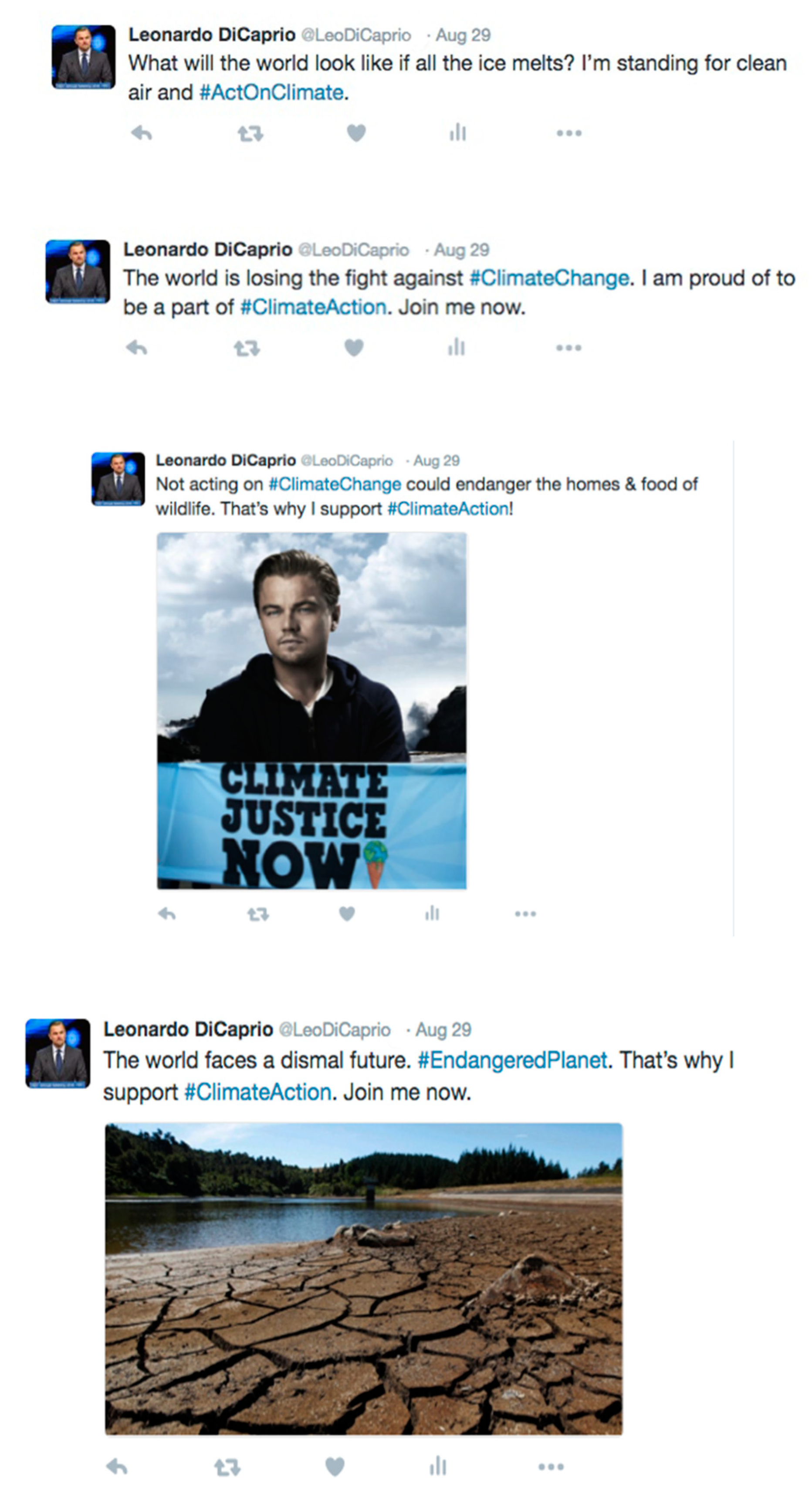
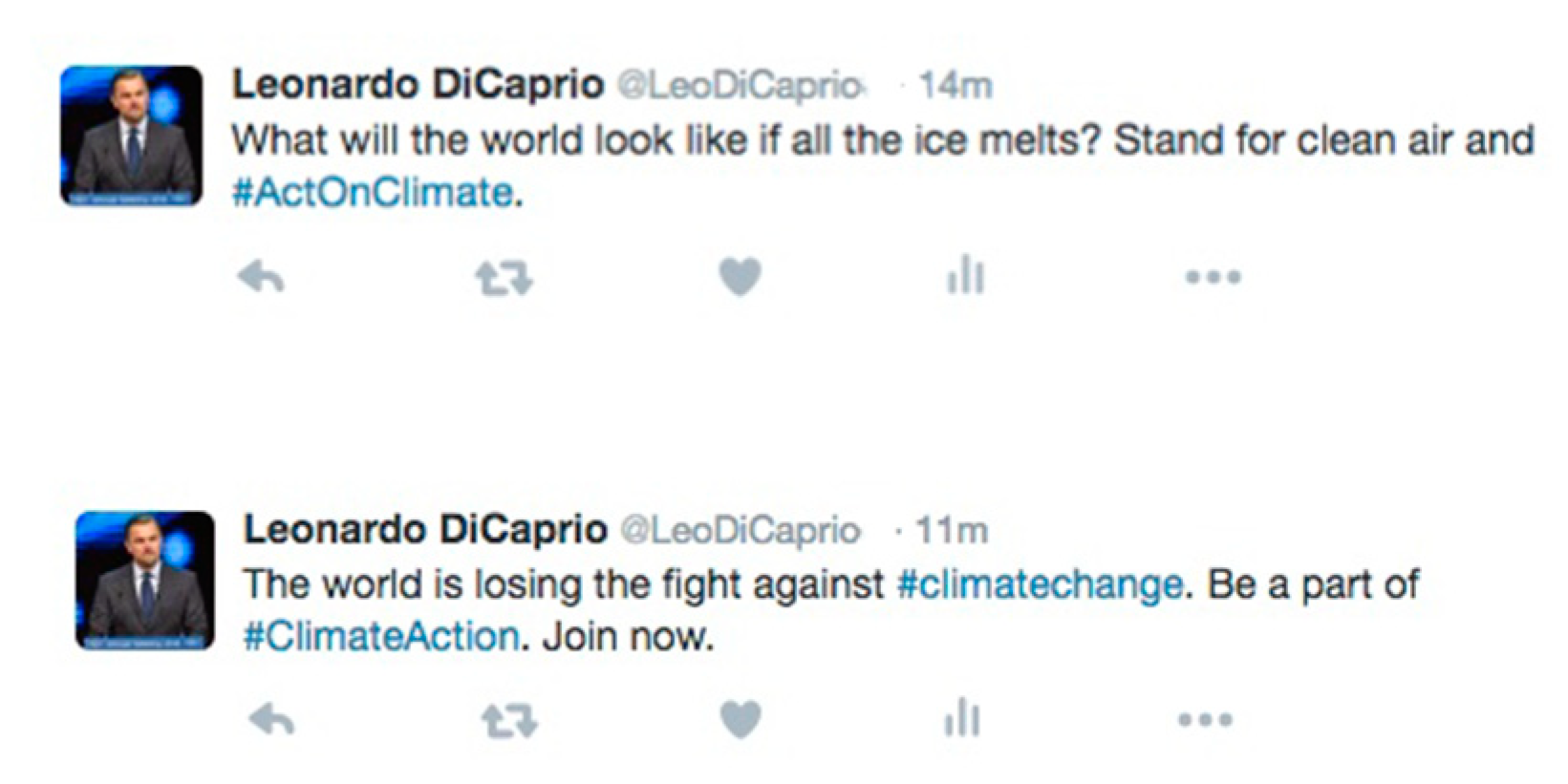
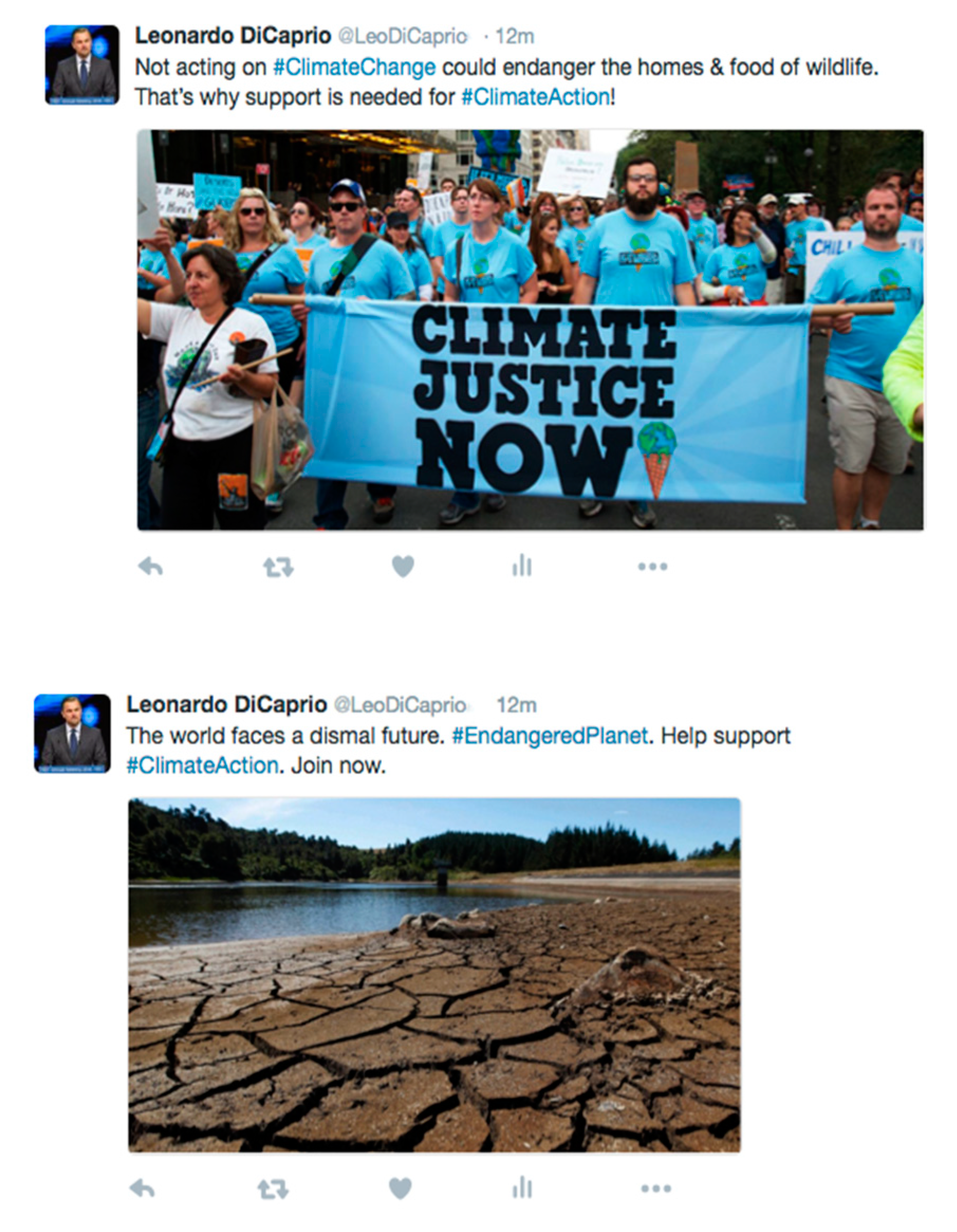
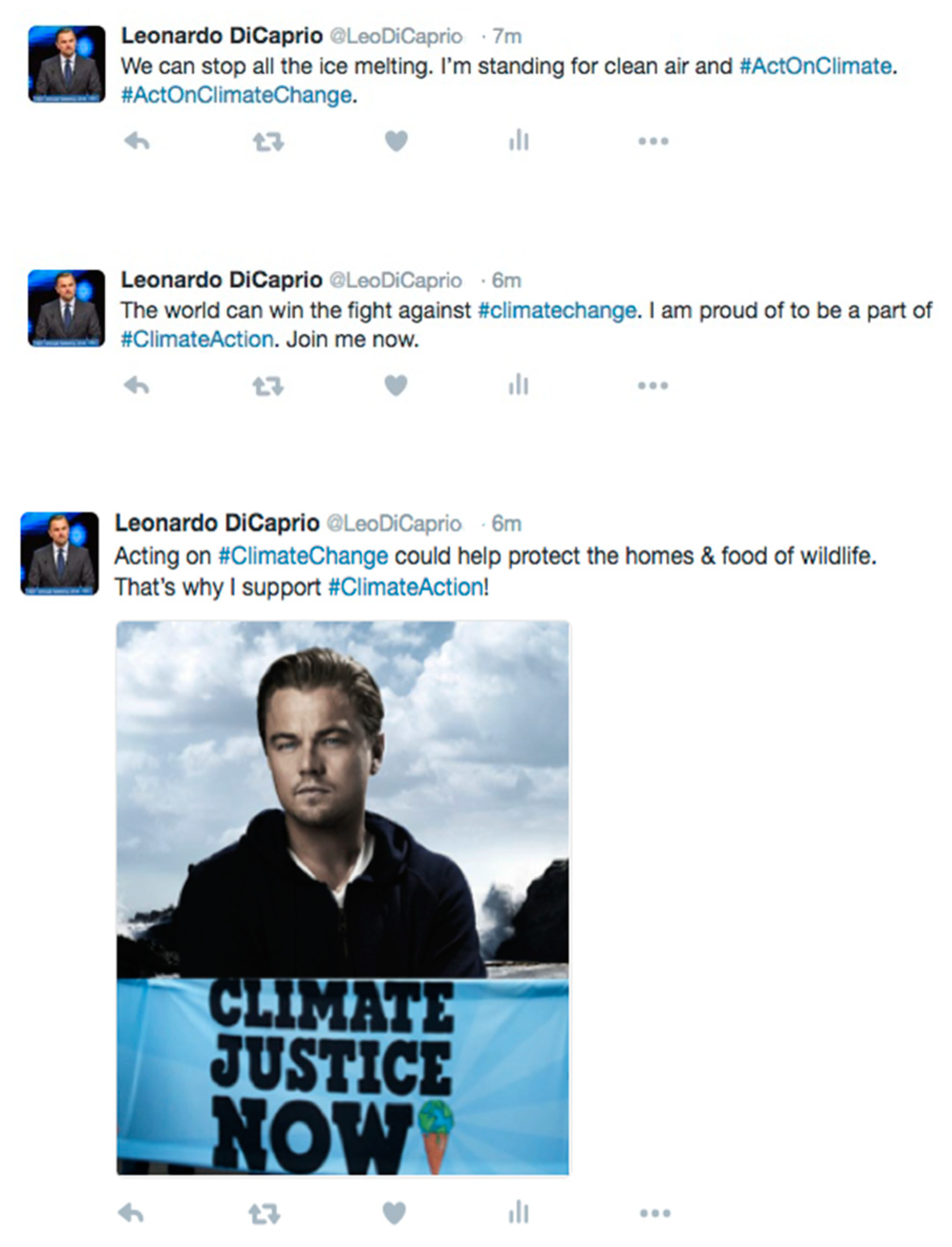

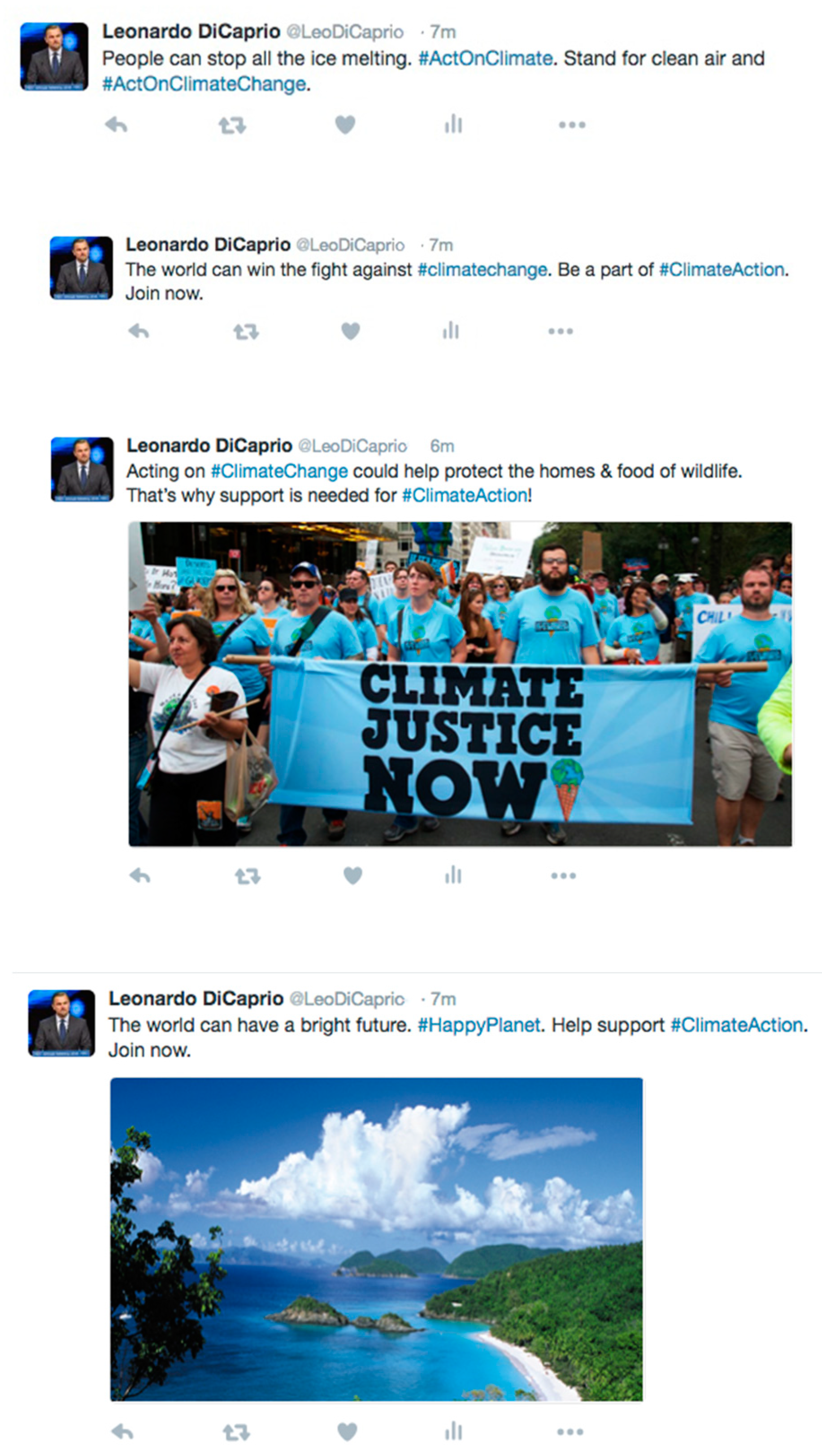


References
- Park, S. We love or hate when celebrities speak up about climate change: Receptivity to celebrity involvement in environmental campaigns. J. Contemp. East. Asia 2019, 18, 175–188. [Google Scholar]
- t’Hart, P.; Tindall, K. Leadership by the famous: Celebrity as political capital. In Dispersed Democratic Leadership: Origins, Dynamics, and Implications; Kane, J., Patapan, H., t’Hart, P., Eds.; Oxford University Press: Oxford, UK, 2009; pp. 255–278. [Google Scholar]
- Brown, W.J.; Basil, M.D. Media celebrities and public health: Responses to ‘Magic’ Johnson’s HIV disclosure and its impact on AIDS risk and high-risk behaviors. Health Commun. 1995, 7, 345–370. [Google Scholar] [CrossRef]
- Brown, W.J. Steve Irwin’s influence on wildlife conservation. J. Commun. 2010, 60, 73–93. [Google Scholar] [CrossRef]
- Spence, A.; Pidgeon, N. Framing and communicating climate change: The effects of distance and outcome frame manipulations. Glob. Environ. Chang. 2010, 20, 656–667. [Google Scholar] [CrossRef]
- Morton, T.A.; Rabinovich, A.; Marshall, D.; Bretschneider, P. The future that may (or may not) come: How framing changes responses to uncertainty in climate change communications. Glob. Environ. Chang. 2011, 21, 103–109. [Google Scholar] [CrossRef]
- Meijnders, A.L.; Midden, C.J.H.; Wilke, H.A.M. Communications about environmental risks and risk-reducing behavior: The impact of fear on information processing. J. Appl. Soc. Psychol. 2001, 31, 754–777. [Google Scholar] [CrossRef]
- Leiserowitz, A. Climate change risk perception and policy preferences: The role of affect, imagery, and values. Clim. Chang. 2006, 77, 45–72. [Google Scholar] [CrossRef]
- Chadwick, A.E. Bridging the Divide between Positive and Negative: The Effectiveness of Hope and Fear Appeals in Climate Change Communication. In Proceedings of the Conference on Communication and the Environment (COCE), Boulder, CO, USA, 11–14 June 2015. [Google Scholar]
- Lorenzoni, I.; Nicholson-Cole, S.; Whitmarsh, L. Barriers perceived to engaging with climate change among the UK public and their policy implications. Glob. Environ. Chang. 2007, 17, 445–459. [Google Scholar] [CrossRef]
- Alexander, J. The case of the green vampire: Eco-celebrity, twitter and youth engagement. Celebr. Stud. 2013, 4, 353–368. [Google Scholar] [CrossRef]
- Amato, F.; Moscato, V.; Picariello, A.; Sperlí, G. Diffusion Algorithms in Multimedia Social Networks: A Preliminary Model. In Proceedings of the 2017 IEEE/ACM International Conference on Advances in Social Networks Analysis and Mining, Sydney, Australia, 31 July–3 August 2017; pp. 844–851. [Google Scholar]
- Moscato, V.; Picariello, A.; Sperlí, G. Community detection based on game theory. Eng. Appl. Artif. Intell. 2019, 85, 773–782. [Google Scholar] [CrossRef]
- Park, S.; Chung, D.; Park, H.W. Analytical framework for evaluating digital diplomacy using network analysis and topic modeling: Comparing South Korea and Japan. Inf. Process. Manag. 2019, 56, 1468–1483. [Google Scholar] [CrossRef]
- Tannenbaum, M.B.; Hepler, J.; Zimmerman, R.S.; Saul, L.; Jacobs, S.; Wilson, K.; Albarracín, D. Appealing to fear: A meta-analysis of fear appeal effectiveness and theories. Psychol. Bull. 2015, 141, 1178–1204. [Google Scholar] [CrossRef] [PubMed]
- MacInnis, D.J.; De Mello, G.E. The concept of hope and its relevance to product evaluation and choice. J. Mark. 2005, 69, 1–14. [Google Scholar] [CrossRef]
- Anderson, A. Sources, media, and modes of climate change communication: The role of celebrities. Wiley Interdiscip. Rev. Clim. Chang. 2011, 2, 535–546. [Google Scholar] [CrossRef]
- Boykoff, M.T.; Goodman, M.K. Conspicuous redemption? Reflections on the promises and perils of the ‘celebritization’ of climate change. Geoforum 2009, 40, 395–406. [Google Scholar] [CrossRef]
- Bromley-Trujillo, R.; Poe, J. The importance of salience: Public opinion and state policy action on climate change. J. Public Policy 2014, 1–25. [Google Scholar] [CrossRef]
- Bramley, N.R. Pronouns of Politics: The Use of Pronouns in the Construction of ‘Self’ and ‘Other’ in Political Interviews. Ph.D. Thesis, Australian National University, Canberra, Australia, 2001. [Google Scholar]
- Pennebaker, J.W.; Lay, T.C. Language use and personality during crises: Analyses of Mayor Rudolph Giuliani’s press conferences. J. Res. Personal. 2002, 36, 271–282. [Google Scholar] [CrossRef]
- Djenar, D.N. Which self? Pronominal choice, modernity, and self-categorizations. Int. J. Sociol. Lang. 2008, 2008, 31–54. [Google Scholar] [CrossRef]
- Horton, D.; Wohl, R.R. Mass communication and para-social interaction: Observations on intimacy at a distance. Psychiatry 1956, 19, 215–229. [Google Scholar] [CrossRef]
- Brown, W.J.; Duane, J.J.; Fraser, B.P. Media coverage and public opinion of the OJ Simpson trial: Implications for the criminal justice system. Commun. Law Policy 1997, 2, 261–287. [Google Scholar] [CrossRef]
- Marwick, A. To see and be seen: Celebrity practice on Twitter. Convergence Int. J. Res. New Media Technol. 2011, 17, 139–158. [Google Scholar] [CrossRef]
- Faul, F.; Erdfelder, E. GPOWER: A Priori, Post-Hoc, and Compromise Power Analyses for MS-DOS [Computer Program]; Department of Psychology, Bonn University: Bonn, Germany, 1992. [Google Scholar]
- Cohen, J. Statistical Power Analysis for the Behavioral Sciences; Academic Press: New York, NY, USA, 2013. [Google Scholar]
- Kellstedt, P.M.; Zahran, S.; Vedlitz, A. Personal efficacy, the information environment, and attitudes toward global warming and climate change in the United States. Risk Anal. 2008, 28, 113–126. [Google Scholar] [CrossRef]
- Hart, P.S.; Nisbet, E.C. Boomerang effects in science communication: How motivated reasoning and identity cues amplify opinion polarization about climate mitigation policies. Commun. Res. 2012, 39, 701–723. [Google Scholar] [CrossRef]
- Gifford, R.; Comeau, L.A. Message framing influences perceived climate change competence, engagement, and behavioral intentions. Glob. Environ. Chang. 2011, 21, 1301–1307. [Google Scholar] [CrossRef]
- Dono, J.; Webb, J.; Richardson, B. The relationship between environmental activism, pro-environmental behaviour and social identity. J. Environ. Psychol. 2010, 30, 178–186. [Google Scholar] [CrossRef]
- Roser-Renouf, C.; Nisbet, M.C. The measurement of key behavioral science constructs in climate change research. Int. J. Sustain. Commun. 2008, 3, 37–95. [Google Scholar]
- Valenzuela, S. Unpacking the use of social media for protest behavior the roles of information, opinion expression, and activism. Am. Behav. Sci. 2013, 57, 920–942. [Google Scholar] [CrossRef]
- Rubin, A.M.; Perse, E.M. Audience activity and soap opera involvement a uses and effects investigation. Hum. Commun. Res. 1987, 14, 246–268. [Google Scholar] [CrossRef]
- Dibble, J.L.; Hartmann, T.; Rosaen, S.F. Parasocial interaction and parasocial relationship: Conceptual clarification and a critical assessment of measures. Hum. Commun. Res. 2016, 42, 21–44. [Google Scholar] [CrossRef]
- Braten, I.; Strømsø, H.I.; Samuelstuen, M.S. Are sophisticated students always better? The role of topic-specific personal epistemology in the understanding of multiple expository texts. Contemp. Educ. Psychol. 2008, 33, 814–840. [Google Scholar] [CrossRef]
- Bentler, P.M. SEM with simplicity and accuracy. J. Consum. Psychol. 2010, 20, 215–220. [Google Scholar] [CrossRef] [PubMed]
- Schuldt, J.P.; Konrath, S.H.; Schwarz, N. “Global warming” or “climate change”? Whether the planet is warming depends on question wording. Public Opin. Q. 2011, 75, 115–124. [Google Scholar] [CrossRef]
- Eden, S. Public participation in environmental policy: Considering scientific, counter-scientific and non-scientific contributions. Public Underst. Sci. 1996, 5, 183–204. [Google Scholar] [CrossRef]
- Patchen, M. Public attitudes and behavior about climate change. Purdue Clim. Chang. Res. Cent. Outreach Publ. 2006, 1–53. [Google Scholar]
- Bandura, A. Social Foundations of Thought and Action: A Social Cognitive Theory; Prentice Hall: Upper Saddle River, NJ, USA, 1986. [Google Scholar]
- Scheufele, D.A.; Tewksbury, D. Framing, agenda setting, and priming: The evolution of three media effects models. J. Commun. 2007, 57, 9–20. [Google Scholar] [CrossRef]
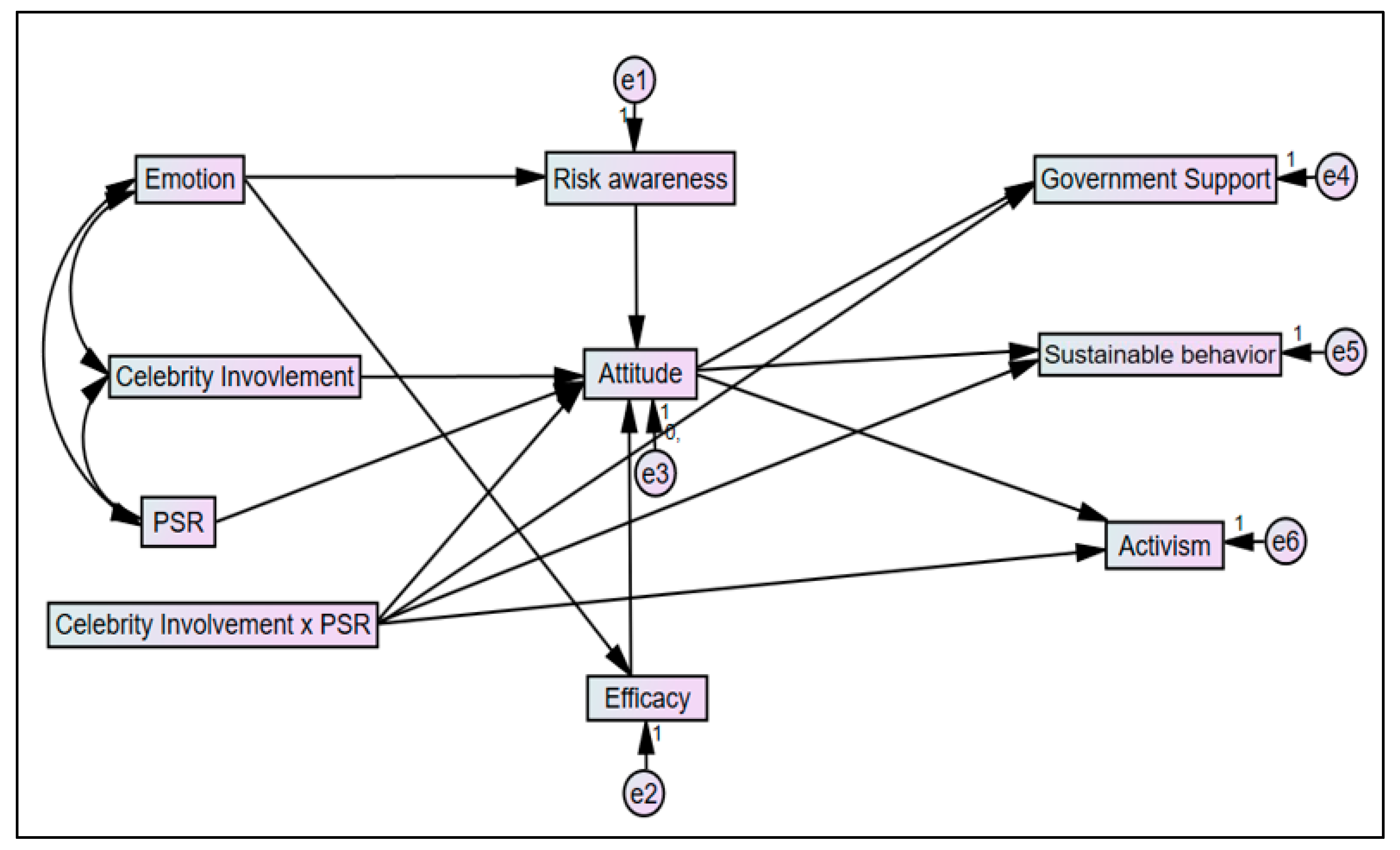

| Variable | M | SD | N |
|---|---|---|---|
| Age | 19.90 | 4.10 | 639 |
| The number of days using Twitter | 4.34 | 2.81 | 343 |
| Twitter daily usage time (minutes) | 90.23 | 147.44 | 316 |
| The number of Twitter followers | 3.81 | 1.57 | 365 |
| The number of Twitter followings | 3.61 | 1.54 | 364 |
| M | SD | Cronbach’s α | |
|---|---|---|---|
| Attitude (3 items) | 4.44 | 1.46 | 0.88 |
| Support for Government Action (5 items) | 5.24 | 1.15 | 0.79 |
| Sustainable Behavior (7 items) | 2.83 | 0.52 | 0.88 |
| Participation in Activism (8 items) | 1.58 | 0.53 | 0.90 |
| Risk Awareness (3 items) | 5.44 | 1.27 | 0.73 |
| Response Efficacy (5 items) | 5.01 | 1.17 | 0.85 |
| PSR (10 items) | 3.84 | 1.34 | 0.91 |
| Political Ideology (1 item) | 3.32 | 1.42 | - |
| Belief in Climate Change (2 items) | 5.68 | 1.25 | 0.82 |
| Knowledge about Climate Change (6 items) | 4.15 | 1.12 | - |
| 1 | 2 | 3 | 4 | 5 | 6 | 7 | 8 | 9 | 10 | 11 | 12 | 13 | 14 | 15 | |
|---|---|---|---|---|---|---|---|---|---|---|---|---|---|---|---|
| 1. Age | - | - | - | - | - | - | - | - | - | - | - | - | - | - | - |
| 2. Gender | 0.073 | - | - | - | - | - | - | - | - | - | - | - | - | - | - |
| 3. Twitter Use | −0.004 | −0.041 | - | - | - | - | - | - | - | - | - | - | - | - | - |
| 4. Emotion | −0.059 | −0.032 | 0.034 | - | - | - | - | - | - | - | - | - | - | - | |
| 5. Celebrity Involvement | 0.007 | −0.116 ** | −0.005 | 0.049 | - | - | - | - | - | - | - | - | - | - | - |
| 6. Attitude | 0.084 * | 0.050 | −0.004 | −0.024 | 0.108 * | - | - | - | - | - | - | - | - | - | - |
| 7. Support for Government Action | 0.057 | −0.051 | 0.030 | −0.019 | 0.016 | 0.338 ** | - | - | - | - | - | - | - | - | - |
| 8. Sustainable Behavior | 0.004 | −0.023 | 0.061 | 0.051 | −0.017 | 0.034 | 0.177 ** | - | - | - | - | - | - | - | - |
| 9. Activism | 0.022 | −0.124 ** | 0.052 | 0.120 ** | 0.005 | 0.110 ** | 0.308 ** | 0.543 ** | - | - | - | - | - | - | - |
| 10. Risk Awareness | 0.041 | −0.079 ** | 0.027 | 0.020 | 0.019 | 0.306 ** | 0.757 ** | 0.153 ** | 0.283 ** | - | - | - | - | - | - |
| 11. Response Efficacy | 0.068 | −0.117 ** | 0.015 | 0.012 | 0.018 | 0.343 ** | 0.682 ** | 0.214 ** | 0.345 ** | 0.594 ** | - | - | - | - | - |
| 12. PSI | −0.057 | −0.055 | 0.004 | 0.116 ** | 0.063 | 0.185 ** | 0.194 ** | 0.081 * | 0.234 ** | 0.166 ** | 0.276 ** | - | - | - | - |
| 13. Celebrity | −0.002 | −0.049 | −0.028 | 0.016 | 0.074 | 0.029 | −0.002 | −0.038 | −0.040 | −0.009 | 0.006 | 0.159 ** | - | - | - |
| 14. Political Ideology | −0.003 | 0.073 | 0.013 | 0.025 | −0.057 | −0.177 ** | −0.248 ** | −0.064 | −0.121 ** | −0.249 ** | −0.125 ** | −0.007 | −0.071 | - | - |
| 15. Belief in Climate Change | 0.033 | −0.073 | 0.058 | −0.001 | −0.011 | 0.268 ** | 0.637 ** | 0.162 ** | 0.248 ** | 0.636 ** | 0.524 ** | 0.170 ** | 0.010 | −0.211 ** | - |
| 16. Knowledge about Climate Change | 0.099 * | 0.051 | −0.006 | −0.046 | 0.026 | 0.140 ** | 0.262 ** | 0.108 ** | 0.108 ** | 0.285 ** | 196 ** | 0.023 | 0.047 | −0.131 ** | 0.216 ** |
| Dependent Variable | Fear Experimental Group | Hope Experimental Group | Control Group | F | df | p Value | Power |
|---|---|---|---|---|---|---|---|
| M (SE), N | M (SE), N | M (SE), N | |||||
| Attitude | 4.43 (0.09), 244 | 4.48 (0.09), 250 | 4.46 (0.12), 129 | 0.091 | 2, 614 | 0.913 | 0.064 |
| Government Support | 5.17 (0.05), 245 | 5.23 (0.05), 250 | 5.32 (0.08), 129 | 1.258 | 2, 615 | 0.285 | 0.274 |
| Sustainable Behavior | 1.78 (0.03), 243 | 1.75 (0.03), 245 | 1.75 (0.05), 126 | 0.142 | 2, 605 | 0.868 | 0.072 |
| Participation in Activism | 1.62 (0.03), 240 | 1.52 (0.03), 244 | 1.59 (0.05), 125 | 2.538 | 2, 600 | 0.080 | 0.508 |
| Dependent Variable | Fear | Hope | F | df | p Value | Power |
|---|---|---|---|---|---|---|
| M (SE), N | M (SE), N | |||||
| Attitude | 4.39 (0.09), 244 | 4.46 (0.09), 250 | 0.329 | 1, 484 | 0.652 | 0.088 |
| Government Support | 5.14 (0.06), 245 | 5.20 (0.06), 250 | 0.550 | 1, 485 | 0.459 | 0.115 |
| Sustainable Behavior | 1.78 (0.03), 243 | 1.75 (0.03), 245 | 0.380 | 1, 478 | 0.538 | 0.094 |
| Participation in Activism | 1.62 (0.03), 240 | 1.51 (0.03), 244 | 5.115 | 1, 474 | 0.024* | 0.617 |
| Dependent Variable | FPP | NFPP | F | df | p Value | Power |
|---|---|---|---|---|---|---|
| M (SE), N | M (SE), N | |||||
| Attitude | 4.58 (0.09), 260 | 4.28 (0.09), 234 | 5.699 | 1, 484 | 0.017* | 0.664 |
| Government Support | 5.18 (0.05), 261 | 5.15 (0.06), 234 | 0.135 | 1, 485 | 0.714 | 0.066 |
| Sustainable Behavior | 1.76 (0.03), 258 | 1.77 (0.03), 230 | 0.133 | 1, 478 | 0.716 | 0.065 |
| Participation in Activism | 1.55(0.32), 253 | 1.58 (0.34), 231 | 0.235 | 1, 474 | 0.628 | 0.077 |
| Path Analysis | Standardized Estimate | ||
|---|---|---|---|
| Participation in Activism | <- | Emotional Framing | 0.08* |
| Attitude | <- | Celebrity Involvement | 0.96* |
| Attitude | <- | PSR | 0.14*** |
| Participation in Activism | <- | PSR | 0.12*** |
| Attitude | <- | Risk Awareness | 0.29*** |
| Support for Government Action | <- | Efficacy | 0.72*** |
| Sustainable Behavior | <- | Efficacy | 0.20*** |
| Participation in Activism | <- | Efficacy | 0.30*** |
© 2020 by the author. Licensee MDPI, Basel, Switzerland. This article is an open access article distributed under the terms and conditions of the Creative Commons Attribution (CC BY) license (http://creativecommons.org/licenses/by/4.0/).
Share and Cite
Park, S. How Celebrities’ Green Messages on Twitter Influence Public Attitudes and Behavioral Intentions to Mitigate Climate Change. Sustainability 2020, 12, 7948. https://doi.org/10.3390/su12197948
Park S. How Celebrities’ Green Messages on Twitter Influence Public Attitudes and Behavioral Intentions to Mitigate Climate Change. Sustainability. 2020; 12(19):7948. https://doi.org/10.3390/su12197948
Chicago/Turabian StylePark, Sejung. 2020. "How Celebrities’ Green Messages on Twitter Influence Public Attitudes and Behavioral Intentions to Mitigate Climate Change" Sustainability 12, no. 19: 7948. https://doi.org/10.3390/su12197948
APA StylePark, S. (2020). How Celebrities’ Green Messages on Twitter Influence Public Attitudes and Behavioral Intentions to Mitigate Climate Change. Sustainability, 12(19), 7948. https://doi.org/10.3390/su12197948




